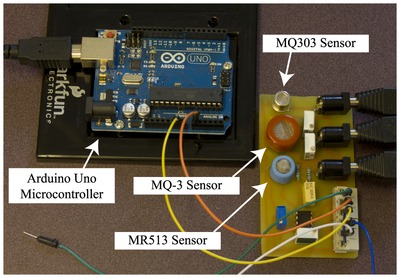Sending messages via molecules
Researchers from the University of Warwick in the UK and York University in Canada have created a molecular communications system which can be used for the transmission of messages and data in challenging environments. Writing in the journal PLOS ONE, the scientists describe “the first modular and programmable platform capable of transmitting a text message using chemical signalling - a method also known as molecular communication”.
The method is common in the plant and animal worlds - many insects use pheromones for long-range signalling, for example. Dr Weisi Guo from the University of Warwick noted that “people have achieved short-ranged signalling using chemicals, but we have gone to the next level and successfully communicated continuous and generic messages over several metres”.

The researchers developed the capability to transform any generic message into binary signals, which are then ‘programmed’ into evaporated alcohol molecules from vodka. The chemical signal, containing the words “O Canada”, was sent four metres across the lab with the aid of a tabletop fan. It was then demodulated by a receiver that measured the rate of change in concentration of the alcohol molecules, picking up whether the concentration was increasing or decreasing.

“We believe we have sent the world’s first text message to be transmitted entirely with molecular communication, controlling concentration levels of the alcohol molecules to encode the alphabet, with single spray representing bits and no spray representing the bit zero,” said York University doctoral candidate Nariman Farsad, who led the experiment.

But the method won’t be used as frivolously as a day-to-day text message: the researchers say molecular communication is “attractive for applications where conventional wireless systems perform poorly, from nanotechnology to urban health monitoring”. Environments where electromagnetic waves cannot be used, and chemical signals offer a more efficient method, include underground structures such as tunnels, pipelines or underwater environments.
“For example, the recent massive clog in the London sewer system could have been detected earlier on, and without all the mess workers had to deal with, by sending robots equipped with a molecular communication system,” said Professor Andrew Eckford from York University.
Dr Guo added, “They can also be used to communicate on the nanoscale, for example in medicine, where recent advances mean it’s possible to embed sensors into the organs of the body or create miniature robots to carry out a specific task such as targeting drugs to cancer cells.” He explained that molecular communication signals are biocompatible, require little energy to generate and propagate, and don’t feature the same constraints as electromagnetic signals do at the nanoscale.
Dr Guo said the idea of “sending a detailed message using perfume … sounds like something from a spy thriller novel, but in reality it is an incredibly simple way to communicate”.
How AI-enabled embedded modules are advancing medtech
AI has been a longstanding focus in medical technology, predating its adoption in other...
Veterinary LIMS improves laboratory efficiency
The North Dakota State University Veterinary Diagnostic Laboratory has significantly benefited...
AI tool enables rapid and cost-effective drug discovery
The Australian-invented AI tool has the potential to reshape virtual screening in early-stage...




